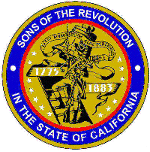Located at 600 South Central Avenue, Glendale, the American Heritage Library and Museum is supported by the generous donations of patriotic Americans who value our nation’s heritage. The Library specializes in genealogical and early American history resources with emphasis on the Colonial and Revolutionary War period. It also has a fine collection of 18th and 19th century vital records, family histories, American military history and English genealogy.
For more than 110 years the American Heritage Library and Museum has been operated and maintained as a service to the community by the Sons of the Revolution in the State of California, an IRC 501(c)(3) non-profit corporation. Use of the Library is free to anyone in keeping with the purpose of the Society "to encourage interest in the early history of the United States . . . to perpetuate the memory of the brave men who fought in the Revolutionary War, and to collect and preserve the manuscripts, records and documents relating to our past."
By the turn of the twentieth century, the Library's collection consisted of 5,000 volumes, an impressive size for the time. Growth of the collection, through direct acquisition and gifts, has been steady over the past 100 years, and has included by gift several major private collections. Today, the Library comprises over 30,000 titles and is well known as one of the largest collections relating to the American Revolution and Colonial America in the western United States. An ongoing fund, supplemented by gifts from the community, facilitates an aggressive books and acquisition program to maintain, broaden and update the collection. The Sons of the Revolution owns the building and collections outright.
HISTORY OF THE LIBRARY AND MUSEUM
From its first meeting on May 8, 1893, the officers of the California Society recognized the importance of the Society maintaining a permanent space in which the members and others could gather. This became even more pressing as the Society began assembling what would become the largest library of its kind in the western United States — the Sons of the Revolution Library.Initially, the office and library of the California Society were maintained at the offices of its first President, Col. Holdridge Ozro Collins, at Room 59, Bryson Block (at the time "Room" was synonymous with the present day term "Suite") at the corner of Spring and Second Streets, Los Angeles.
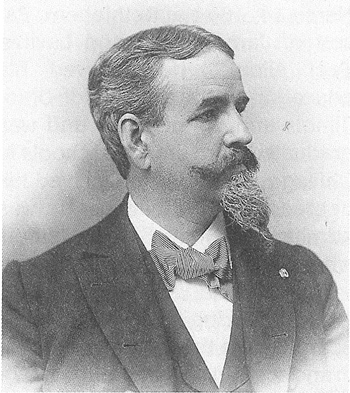
HOLDRIDGE OZRO COLLINS
First President of the Society and
General Historian, General Society Sons of the Revolution (1902- )
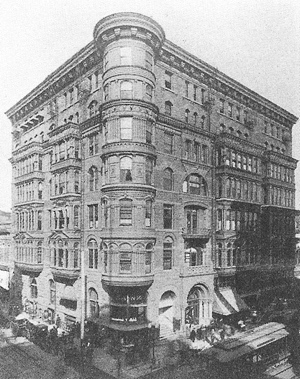
BRYSON BUILDING
Spring and Second Streets
Los Angeles - 1893
In June, 1894, the headquarters and library of the Society moved with Col. Collins to a new location, Rooms 404-405, Stimson Building, remaining there until 1897.
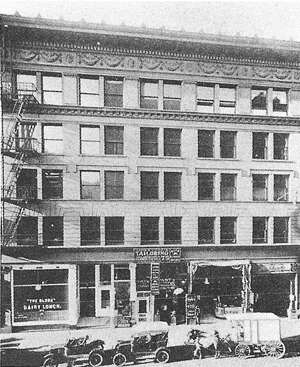
STIMSON BUILDING
Spring and Third Streets
Los Angeles - 1894-1897
By 1897, burgeoning growth of the Library caused the California Society's headquarters and library to move from space shared with President Collins' offices to its own quarters. Like an infant growing into adulthood, over the succeeding 18 years the collection's growth caused the Library to be relocated to successively larger quarters four times. By the turn of the 20th century its collection contained over 5,000 volumes, considered quite large at the time.
By then, it was felt that the Society was strong enough to “stand on its own feet” and, accordingly, it rented Room 412, Henne Building (122 West Third Street), across the street from its former location, paying rent of just nine dollars per month. Shelves, tables, chairs and other conveniences and equipment were installed, and the place made comfortable and home-like. On February 22, 1898, the first elections to occur at the Society’s own quarters took place.
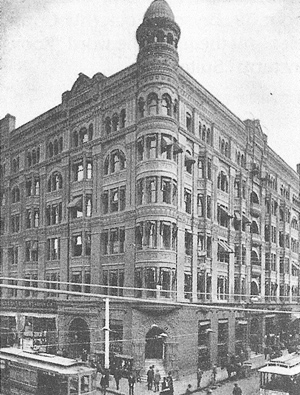
HENNE BUILDING
122 West Third Street
Los Angeles - 1897-1908
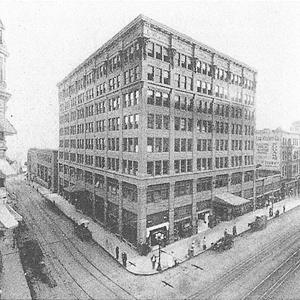
SAN FERNANDO BUILDING
Fourth and Main Streets
Los Angeles - 1908-1915
Even this stop-gap measure proved insufficient. By mid-1918 overcrowding again became a problem.
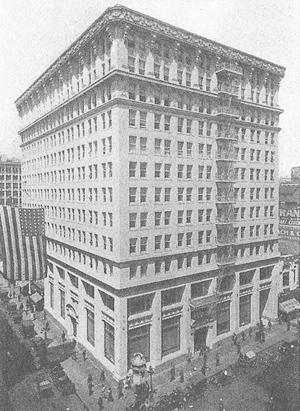
CITIZENS NATIONAL BANK BUILDING
Spring and Fourth Streets
Los Angeles - 1915-1929
The SR Library's growth over the next 85 years was staggering — nearly ten-fold. By 1919, already flourishing and its permanence assured, the California Society sought to deepen and broaden its roots as a permanent organization. Principal among its aims was the establishment of a solid financial footing and, at some point in the future, a wholly owned building in which to house the Society and what had become its prominent library. A systematic campaign was begun for gifts of historical, genealogical and biographical books for the Library.
The California Society's first owned building and library was made possible in 1926 by the generous gift of a prime site by Nathan Wilson Stowell, a real estate and manufacturing philanthropist, and member of the Society.
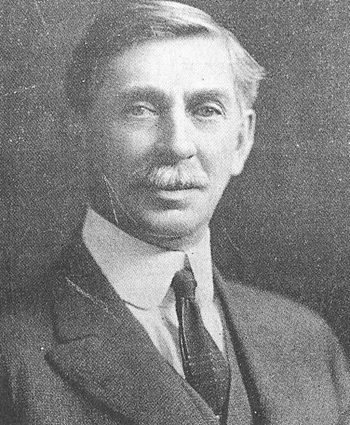
NATHAN STOWELL
Real Estate Entrepreneur and Philanthropist
The site, located in the core of the central business district in Los Angeles, was a portion of Lot 1, Block T, in the Mott Tract, 44.5 feet frontage by 41 feet depth, was given on the condition that there be placed thereon “a fireproof building” suitable to the needs of the Society. Luther Hill, a member of the Society, was in charge of construction. Dr. Edward M. Pallette, the Society’s President, appointed Cassius Milton Jay, Erving P. Tucker and Lewis A. Winston to serve as members of the Building Committee.
The plans for the building, two stories in height, were submitted by Mr. Stowell himself, contemplating a cost of $25,000 for its total construction. In design, the motif followed the lines of certain architectural features of Philadelphia’s Independence Hall. In fact, the building was a seven-eighths scale model of the famous building.
On the morning of October 10, 1927, the first shovelful of earth was turned by Capt. Willis Milnor Dixon, who had been a member of the California Society for thirty years. Dr. Edward M. Pallette, President of the Society, presided at the ceremony which was opened by Rt. Rev. William Bertrand Stevens, Episcopal Bishop of Los Angeles and himself a member of the Society. [Bishop Stevens served as General Chaplain, General Society Sons of the Revolution, 1940-1947.] Past Society President Orra Monnette, first President of Bank of America and Chairman of the City of Los Angeles Library Commission, delivered the dedicatory address. [Monnette served as General Historian, General Society Sons of the Revolution, 1918-1919.]
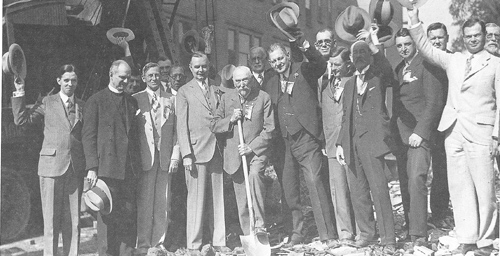
Groundbreaking at 437 South Hope Street, Los Angeles.
Monday, October 10, 1927 at 9am
From left to right: Lansing Sayre; Rt. Rev. William Betrand Stevens; William Bowne Hunnewell (Gov., California Society of Colonial Wars. 1926-27); Philip E. P. Brine; Dr. Daniel L. Ransom; James D. Hurd; Dr. Edward M. Pallette, President; Wilson Milnor Dixon, Librarian (holding shovel); Charles B. Messenger; Orra Eugene Monnette (waiving hat); Charles F. Bouldin; Dr. Egerton Crispin; unknown; Cassius Milton Jay, Secretary; Col. Harcourt Hervey, Marshal; Edward Bouton, Jr.; Dr. James D. Eaton.
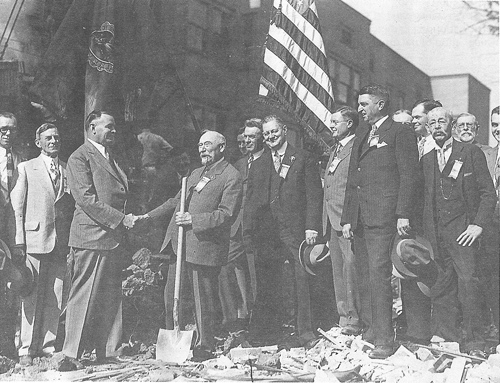
Groundbreaking at 437 South Hope Street, Los Angeles.
Monday, October 10, 1927 at 9am
From left to right: Charles F. Bouldin; William Bowne Hunnewell (Gov., Colonial Wars); Edward M. Pallette, President, shaking the hand of Willis Milnor Dixon, Librarian; Lansing Sayre; John Emerson Marble; Orra Eugene Monnette (holding hat); Dr. Egerton Crispin; Cassius Milton Jay; Burnham Robert Creer (partially hidden); Edward Bouton, Jr.; unknown; Dr. James Demarest Eaton; and Dr. Daniel L. Ransom.
The Sons of the Revolution Library opened in 1928, making available to the public 20,000 volumes. An invitation to share the Society's new building as office headquarters was extended to three other hereditary Societies then active in California: the Society of Colonial Wars, Order of Founders and Patriots, and the Mayflower Society. Thus began the tradition of the SR Library being the focus and headquarters for several patriotic and hereditary societies that continued for many years.
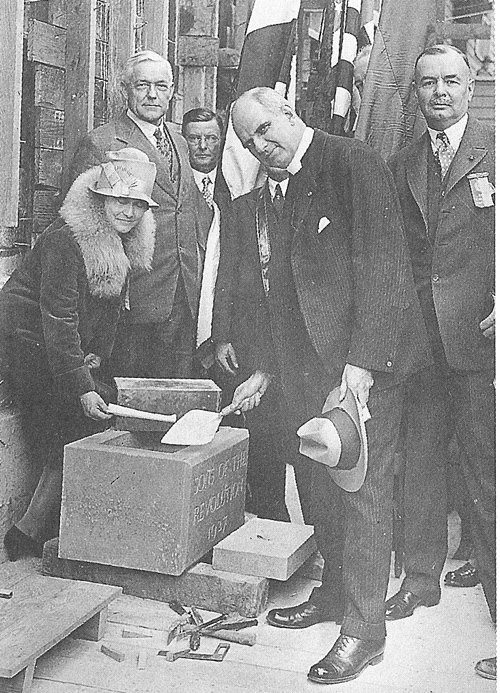
Placing the Time Capsule in the Cornerstone
From left to right: Mrs. Frank Pettingell; Hon. Benjamin Bledsoe (U.S. District Judge; future Society President and General President Sons of the Revolution); Dr. Egerton Crispin; Bishop William Bertrand Stevens and Dr. Edward Pallette.
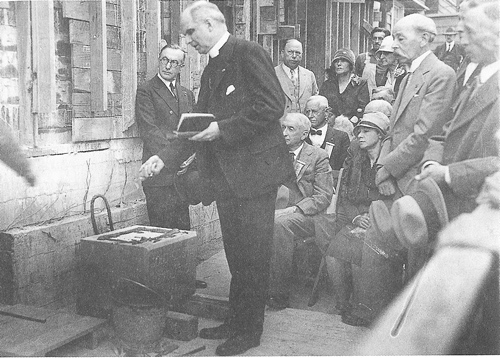
Ceremonial Laying of the Cornerstone
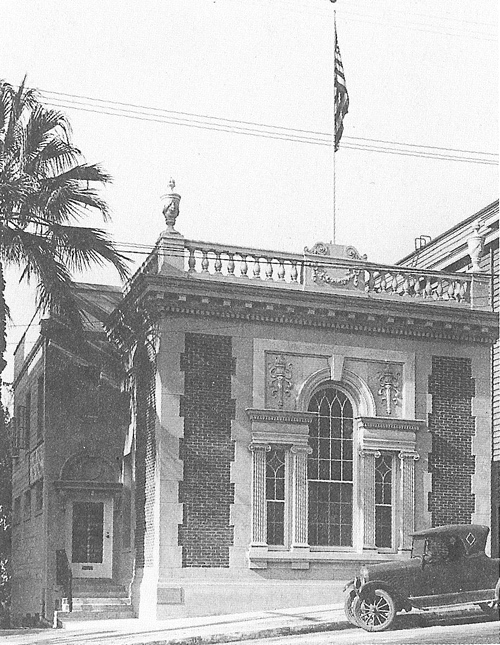
Completed Headquarters and Library Building
437 South Hope Street, Los Angeles
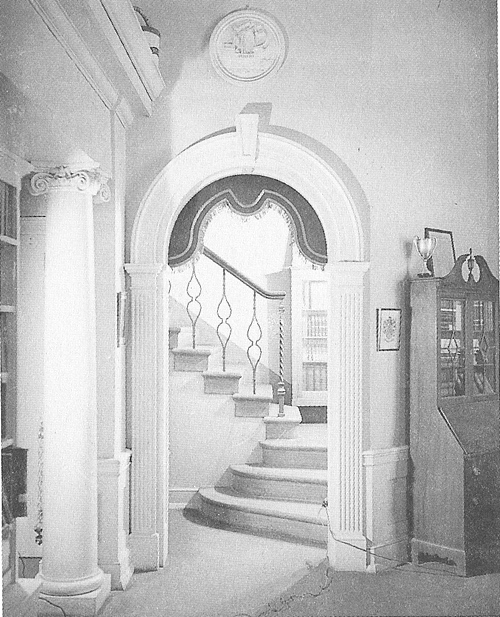
Entry Foyer of the Hope Street Building
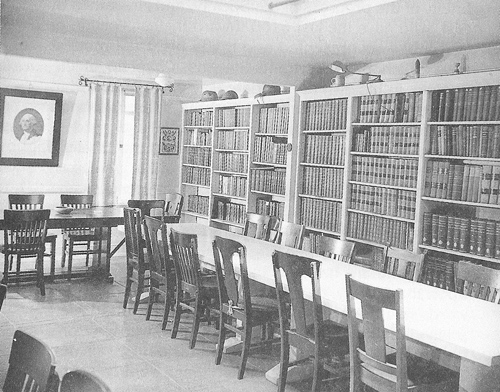
One of the Library's Reading Rooms
The general contractor for the building was Scofield Engineering and Construction Company, headed by Messrs. E. M. Scofield amd F. J. Twaits, with offices in the Pacific Finance Building, located on the west side of Hope Street between 6th and 7th Streets. Known previously as Pacific Marine Construction Company of San Diego, among the firm’s of notable projects was the large shipyard built in San Diego between 1914-1918. The firm relocated to Los Angeles in 1920. One of its first local projects was the Pacific Mutual building on 6th Street, a massive project for the time, covering almost the entire block from Grand Avenue to Olive Street. The company also built Good Samaritan Hospital, United Artists theater, Biltmore Theatre and the Biltmore Hotel addition.
Actual construction commenced April 1, 1928.
Mortgage Retirement
The Society formed a Mortgage Retirement Committee which worked in earnest over several years to raise sums sufficient to fully retire the debt against its new building. Outright gifts towards a mortgage retirement fund were received from several members of the society, including a significant gift from the estate of Seth Marshall.
In the July-September, 1935 issue of The Bulletin, Vol. XII, No. 3, the official publication of the Society, the following account of the Society’s mortgage retirement said it all:“On that day the mortgage, the last remaining evidence of indebtedness subsisting against the Society, was duly and truly burned and consumed and cast into the discard of things that were but are no more. Dr. E. M. Pallette, Chairman of the Mortgage Retirement Committee, opened the meeting with the appropriate story of a real “news” item; not the proverbial man biting the dog, but the almost equally unheard-of event in these days of depression – a debt or paying off the mortgage instead of having it foreclosed.
Dr. Wilbur W. Beckett, a Past President of the Society, spoke briefly of the progress of the Society, and Mr. James B. Gist, who gave the last $100 toward the satisfaction of the debt, was presented and made his usual modest bow.Bishop W. Bertrand Stevens, Chaplain of the Society (and Episcopal Bishop of Los Angeles), in his own appropriate way pronounced what might be not irreverently turned the “blessing” upon the occasion, and Mr. Orra E. Monnette, a Past President of the Society and general doer of things in and for the Society, delivered the speech of the day.
Willis M. Dixon indulged in a cute interesting reminiscences and Librarian N. W. Stowell, who gave the land upon which the building of the Society was erected, was called for, but, with a modesty befitting the man but wholly out of keeping with the nature of the benefit he had conferred upon the Society, he failed to respond. After all good words have been spoken and much worthy and timely praise and indulged in with respect to those whose efforts had made the Society possible, President E. Palmer Tucker, receiving the Note and Mortgage from Treasurer Cassius M. Jay, duly converted it into ashes and the California Society was out of debt and unembarrassed wood leans upon its property.”
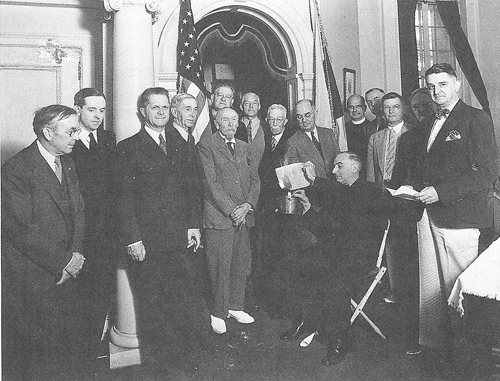
Burning the Mortgage
From left to right: unknown; Lansing Sayre; unknown; Nathan Wilson Stowell (donor of the land); Willis Milnor Dixon; Orra Monnette (organizer and first President, Bank of America NT&SA); Hon. Benjamin Bledsoe (Federal judge; General Registrar, General Vice President, 1934, General President, SR, 1937); W. W. Beckett; James Black Gist; E. Palmer Tucker, President (sitting); Rt. Rev. William Betrand Stevens (Episcopal Bishop of Los Angeles, General Chaplain, General Society of the SR, 1940-1947); Dr. Edward M. Pallette; Egerton Crispin; unknown; and Cassius Milton Jay (Treasurer).
The remainder of Lot 1, Block T, in the Mott Tract, where the Society’s headquarters was built, became available in 1944. Frank S. Lint brought this information to the Society. Although the owner of the property adjoining to the south had offered several thousand dollars just for a driveway alone, and would have bought the remaining four-fifths of the lot, through the persistence of Mr. Lint the Society acquired it for just $1000 from its owner, the Lacey Estate. The Society did not have the funds available for the purchase, but through the generous contribution of funds by some 40 members the sum was probably raised. For a time, the Society’s board declined to acquire the land because of a fear that the property would not have been free from ad valorem property taxes or assessments, thus placing a financial burden upon the Society. The matter was taken to the Los Angeles County Assessor, who granted the joining of this additional four-fifths lot to the original one-fifth lot on which the building stood, making the entire lot property tax-free, with the understanding that no portion of it would be used for commercial income purposes. The entire lot was 64.5 feet in width and 165 feet in depth.
Eminent Domain
In 1964, the existence of the Society's Headquarters and Library building was threatened by a massive urban renewal project. Despite popular support and pleas by the California Historical Society and other organizations, the California Society was forced to vacate its building in an eminent domain action that paved the way for the Bunker Hill Redevelopment Project. The Society's headquarters was one of 396 buildings located in the massive 136-acre redevelopment area.
After 36 years, the California Society once again had to find a new home. The property was sold to the Bunker Hill Redevelopment Agency for consideration that included reimbursement for the cost of two year's storage of the Society's library and equipment from the date of the move from the Hope Street building in November, 1968.
By the end of November, 1970, and in spite of a diligent search for an adequate new property, the Society had not found a new home. Several alternatives were considered at the time, including: moving the collection to an estate offered by a member; acquisition of the library collection by the City of Los Angeles Public Library; housing of the library at the Los Angeles Mormon Temple Library; and donation of the library to Pomona College (at Claremont). None of these alternatives suited the Society's needs or long term objectives. Rather than continuing to pay considerable storage costs, it was decided to lease temporary space in the Granada Building on Lafayette Park Place, just off Wilshire Boulevard in Los Angeles.
Interim Headquarters and Library
Having lost its beautiful headquarters facility through eminent domain, the California Society moved its library and headquarters on an interim basis to rented space that it occupied from 1968-1971. Only a portion of the Library's collection, about 10,000 titles, were available to patrons.
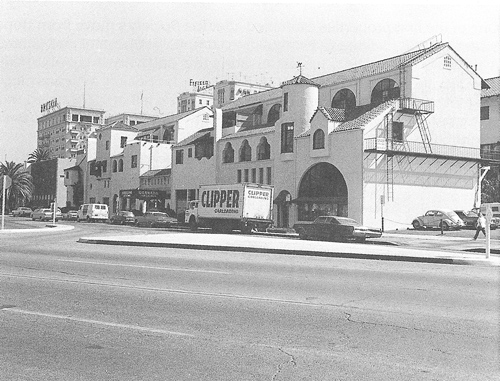
Granada Building - 672 So Lafayette Park Place, Los Angeles
1968-1971
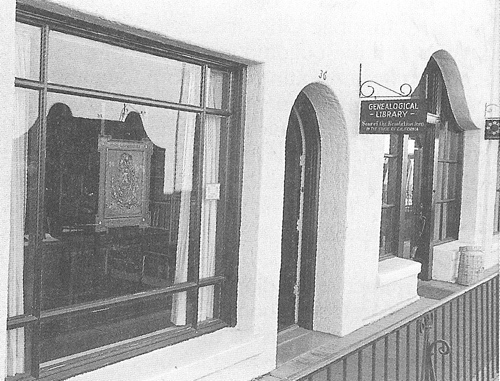
Entrance to the Granada Building Library
Second Floor
The Society's Current Owned Building
One of the first properties examined after the Society's move from Hope Street in 1968 had been a two-building complex at Chestnut and Central Avenues in Glendale. It was an attractive and very adaptable site, however the price to acquire it was beyond the Society's means since the owner wanted to sell it as one parcel. In the fall of 1972, word was received that the property was once again available and that the owner might consider dividing the property to expedite a sale. An offer was made on the larger of the two buildings, located on the corner, in November, 1972. After several weeks of negotiations, satisfactory terms were reached. The Society had a new home.
In December, 1972, the California Society entered into an agreement to purchase the land and a 4,300 sq ft building located at the southeast corner of Central Avenue and Chestnut Street in Glendale. Consisting of a high-ceilinged 3,700 open space with large windows and fireplace, plus 600 sq ft of additional space on two floors, it was ideal for use as the Society's library and headquarters.
The building contained nearly twice the amount of space than was then occupied. Utilizing proceeds from the sale of its first building, the Society paid all cash for this new facility and closed escrow on April 5, 1973. The SR Library has remained at this location ever since.
The Spanish-style building sits on a concrete slab with solid masonry walls and roof coping of red tile. Fully air-conditioned, it was built in 1929 for the Glendale Chamber of Commerce and was at one time occupied by the Automobile Club of Southern California. The Society subsequently brought the building into strict compliance with current earthquake codes. The site was ideal because of its easy accessibility and location in a good neighborhood bustling in the midst of a new regional shopping mall and expanding corporate center.

Sons of the Revolution Headquarters, Library and Museum
600 South Central Avenue, Glendale
1973 to present
The interior of the attractive building was completely redecorated, with new lighting fixtures, new steel bookcases and colonial style furniture. Thirty Windsor chairs, new but of authentic colonial design, were purchased in New England, each paid for by a Society member who in return had his revolutionary war ancestor's name engraved onto a plate that was affixed to the chair. Air conditioning and heating was repaired and a copy machine purchased.
Members donated most of the new library's furnishings: Colonial flags, office furniture and equipment; a Coat of Arms of George Washington; desks; gas lamps; and sizeable donations for new books and book binding. Books in poor condition were rebound and groups of volunteers re-catalogued the entire collection of genealogies, histories and manuscripts.
After minor renovations, the library opened in mid-June, 1973. In the beginning months, the library averaged 25 researchers daily. They were ably assisted by volunteers led by the Society's Librarian, SR General Vice President Richard Erlich Coe.
In the first six months of operation, 300 new books were acquired, largely through donation. An annual book purchase fund was also established.
The Society's historical and genealogical library is not only a showplace but a very practical library from which people can trace their lineages as a hobby or as the means of joining hereditary societies such as the Sons of the Revolution, Daughters of the American Revolution, Society of Colonial Wars, Society of the Cincinnati, the Aztec Club and others. It is open to the public.
See also: On Bunker Hill, A Lost Neighborhood Found.
Official Repository
General Society, Sons of the Revolution
The American Heritage Library, formerly known as the Sons of the Revolution Library, is designated as the repository for the General Society Sons of the Revolution. It has a collection exceeding 30,000 volumes. The California Society continues to purchase books and periodicals for the library collection through an aggressive, on-going acquisitions program and it regularly receives donations of books as well. Other state societies are encouraged to send copies of their publications for inclusion in this permanent archive. The Library and building are wholly owned by the California Society debt free and maintained as its principal patriotic project.
An extensive renovation and expansion of the Library facility spanning several years was completed in late-1999 which included a new roof, additional shelving, two state-of-the-art computers for patron use supported by an extensive collection of CD-ROM resources, construction of two offices and a Board room.
In addition to its magnificent collection of books, manuscripts and CD-ROMs, the Library displays several of the Society's rare artifacts, including an original leopard skin saddle pad owned by Gen. Edward Braddock and later presented to George Washington in recognition of Washington's heroism; a handsome oil painting of Gen. John C. Fremont, painted from life; and a silk flag carried in the First Trade Procession of Boston, in 1789. Gen. Washington passed through the open ranks of the procession on a white horse. Only two such trade banners were known to exist in 1922 when it was acquired by the California Society. A rotating exhibit of more than a dozen full-sized colonial flags adds further color to the facility.
Phased Expansion and Modernization
2003-2006
During 2002 the Library began the process of creating a computerized catalog of its holdings. Since late 2003 the catalog has been searchable on-line at this web site.
Over the past few years many wonderful improvements have taken place at the Library, making it even more significant as one of the largest genealogical libraries of its kind.
Among the significant accomplishments is the tripling of shelf space to make available more books, manuscripts and records for patron use. Thousands of new books have been added to the collection. See the page on Recent Acquisitions for our most recent additions.
The Society completed a quarter-million dollar modernization and collection organization project, bound many years of journals and periodicals of varying titles, expanded its book collection by several thousand titles, added shelving, computers, and more. We installed a new two-zone heating and air conditioning system to replace our 30-year old system, laid insulation in the attic and installed attic fans.
The SR Library is a member of OCLC, a worldwide library cooperative, through which more than 53,548 libraries in 96 countries and territories around the world have access to our catalog.
In September, 2006 the Society received the Award of Merit from the American Association of State and Local History, the most prestigious national award for achievement in the preservation and interpretation of state and local history. See the AASLH Award page linked above for more information.
In 2007 the Library's name was changed to the American Heritage Library to reflect not only our genealogical and historical focus, but to encompass our overall mission, and commitment to telling the American story.
In addition to a fine collection of books, periodicals and manuscripts, many of which are rare out-of-print first editions, the Library is blessed with a magnificent collection of artifacts.
Our Library and Museum continues to grow in whole new ways and in new directions to meet the challenges of the twenty-first century, but our mission is the same as when the Library first opened more than one hundred ten years ago, in 1893: 1.) to perpetuate the memory of those who risked their lives and fortunes to form this great nation, and 2.) the collection, preservation and sharing with the public manuscripts, records and writings relating to American Independence and our nation’s heritage. It is our mission to ensure that succeeding generations know what it means to be an American.
The American Heritage Library and Museum is an affiliated library and museum of the California State Military Museum.
Ventura Fwy (134) east to Central Avenue (Glendale), south two blocks past the Glendale Galleria.
600 South Central Avenue
Glendale, California 91204
818-240-1775
Download a brochure by clicking here.
Persons interested in providing volunteer services in support of the maintenance, operation or leadership of the Library are encouraged to become part of our support group.
Contributions and donations of books are encouraged. The Library receives no financial support from the city, state or Federal government, and depends on donor generosity to provide the means of continuing, improving and expanding service to the community.
© 2022 Sons of the Revolution in the State of California, Inc.
